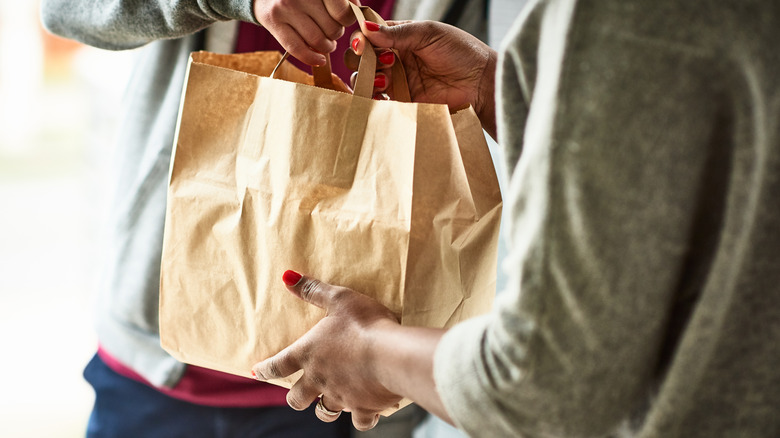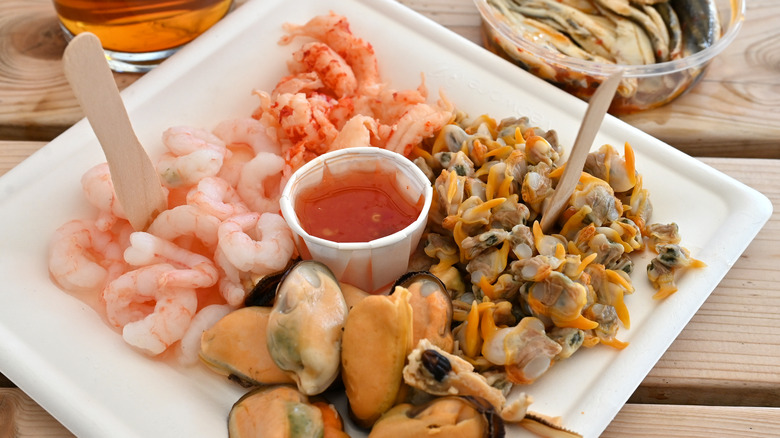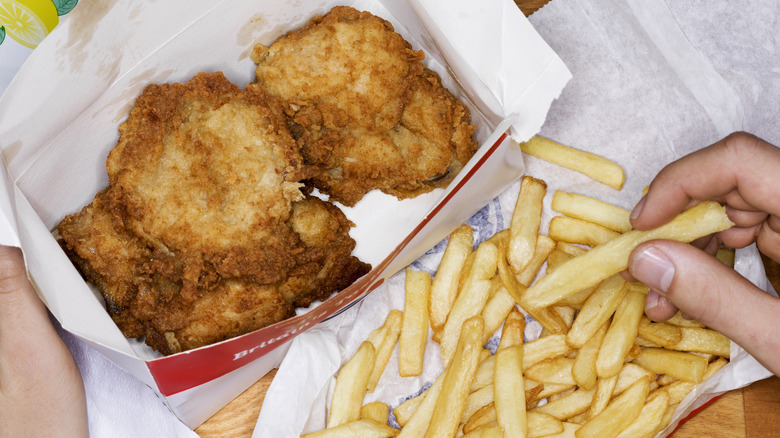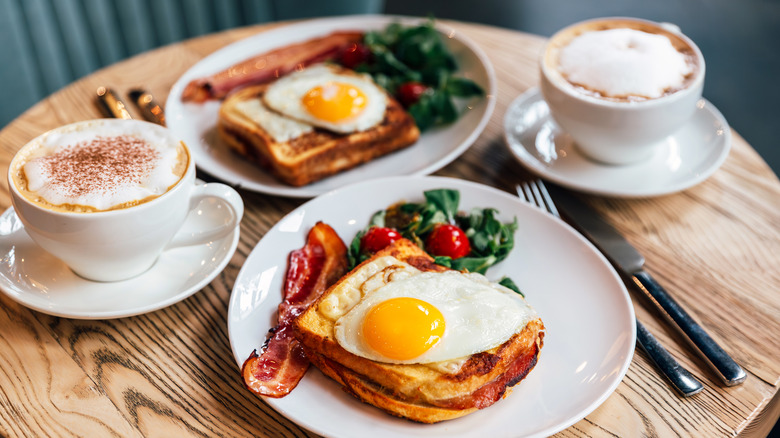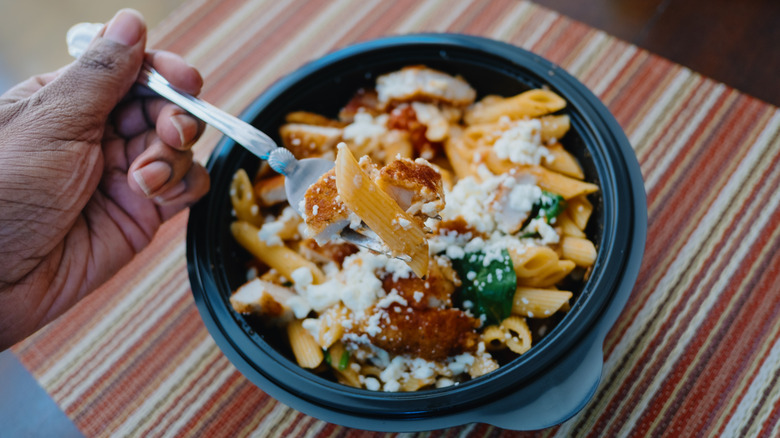5 Foods You Should Avoid Ordering For Delivery
Food delivery apps bring an entire city's dining selection right to our fingertips. And while it's certainly tempting to enjoy all sorts of tasty fare in the comfort of the home, that doesn't always mean it's a good idea. Many foods require a delicate balance of timing and temperature to deliver the best dining experience; they're meant to be consumed on the spot and then gone at a moment's notice. Sure, everything might seem perfect at a restaurant, but place certain dishes in a to-go container, and they'll rapidly lose their magic.
After all, transport impacts foods in unexpected ways. Sauces either clump together or lose stability and come apart. Proteins can keep cooking in steam-filled containers. And textures meant to be crispy and delightful are anything but. Complicated by the fact that not all restaurants follow the same boxing protocol, and there are some dishes that just aren't worth the risk. So, settle in with a delivery-food favorite like pizza or Asian takeout, and steer clear of these delicate options.
Delivery seafood might sadden you
It doesn't get more delicate than seafood. It's less forgiving than meat, meaning just a few minutes too short or long, and the dish can taste off. Throw a hot serving into a boxed container, and the excess heat creates a spontaneous steamer, putting your precious oceanic bounty at risk of overcooking. Whether it's lobster, a fish filet, or shrimp, the extra transportation time can completely ruin the chef's intentions.
A perfectly flaky cod packed in foil will turn mushy, while that lobster will get rubbery, and hard-to-chew. And mollusks like clams, mussels, and scallops are certainly worth avoiding, since they taste best fresh. To cap it off, seafood dishes tend to be pricier, so there's bound to be disappointment when the eye-catching plated seafood tower in the photo doesn't match expectations.
There are a few exceptions: Namely, chilled seafood like tuna salad or crab dip. Sushi from a trusted restaurant will transport well, too. However, it's best to avoid raw fish from an unknown delivery source, as you can't gauge the quality and fish type before arrival at your house.
Fried foods lose their luster
Battered and fried foods are also prone to textural issues in the takeout container. The appeal of delicious fries or onion rings is in their crispiness; place it into a box, however, and sogginess awaits. Once condensation builds in the container, any crust or crunchy exterior will turn unappealingly soft. Occasionally, takeout restaurants will use purposefully-built containers with holes for aeration, but the practice isn't ubiquitous, and it doesn't always work as intended.
Furthermore, anything with breading is especially prone to textural degradation. The possibility of the crisp coating falling off during transport is a major risk. So, dishes like mozzarella sticks or thinly pounded schnitzel are best enjoyed in person. And definitely don't bother with dishes that combine fried foods with other ingredients. Over time in transit, a fried chicken sandwich will turn into a moist mess, and katsu curry will lose its textural contrast. So, for optimal enjoyment, head to the drive-thru or dine-in at the restaurant itself to enjoy fried foods at their finest.
Delivery steak temperature is hard to get right
Steaks require lots of careful supervision. There's the timing required during searing or grilling, followed by minutes spent resting so the meat retains its juiciness. However, in a takeout container, the entire balance gets thrown off since the contained heat keeps the cooking process rolling along, potentially bumping your steak from medium rare up to well done. Furthermore, as the meat cools, the chewiness will only be more accentuated, yielding an unappetizing culinary experience.
If you absolutely have your heart set on takeout steak, your best bet is to request an order cooked to a degree below your preference. Say you're a fan of medium — you'll want to request medium-rare. So, if you order steak from your favorite chain restaurant and it still arrives below your preferred temperature, just heat up a skillet and give it a quick sear on each side. Nevertheless, it's fair to say that cooking a takeout order defeats the point. You may as well commit to purchasing a raw steak yourself, and cooking the dish from scratch.
Brunch is best enjoyed in-person
Another tempting choice to avoid altogether? The majority of brunch classics. Eggs are a finicky food whose culinary magic quickly wanes when sitting out. Just imagine the potential disaster with eggs Benedict disheveled inside a container. Fried eggs, scrambles, and omelets won't fare much better — no one wants those dishes overcooked and cold.
Of course, eggs aren't the only culprit. Other morning foods are also better fresh and hot. There's a reason those buttermilk pancakes and waffles are enjoyed right off of the griddle; they firm up and take on an unappealing rubbery quality with time. As for bacon, the rendered fat can leave nearby food a greasy mess, all the while the cured pork itself turns dry. And sure; a nice atmosphere can be created in the home. However, there's a special buzz to the best brunch spots that can't be transmitted through an app. Add up all these factors, and this meal is best to skip for delivery.
Fresh noodles and pasta don't travel well
A serving of freshly made noodles certainly sounds like an appealing delivery. A dish of long chewy-strands, covered in a tasty sauce and enjoyed on the couch — it certainly seems cozy. Unfortunately, those takeaway pasta dreams rarely, if ever, come true. Hot pasta is also prone to carry-over cooking, and any complementing sauce will only make it worse. Not only will the noodles pass al dente, they'll also sop up any liquid, potentially turning them into a particularly mushy mess.
Rice noodles have the opposite issue — as they cool, they can turn brittle. And soupy noodle dishes like ramen also get wonky with temperature changes. Some restaurants do account for delivery, slightly undercooking their noodles and packaging the broth separately. So, it's not entirely necessary to rule out takeout, just know that the result highly depends on the establishment you're ordering from.
